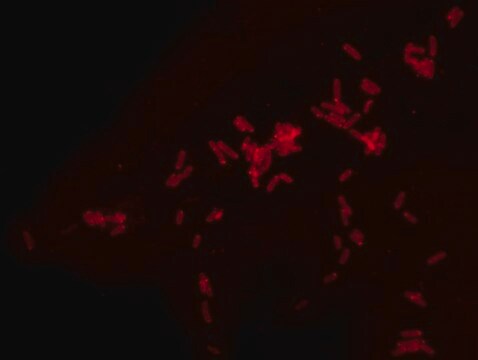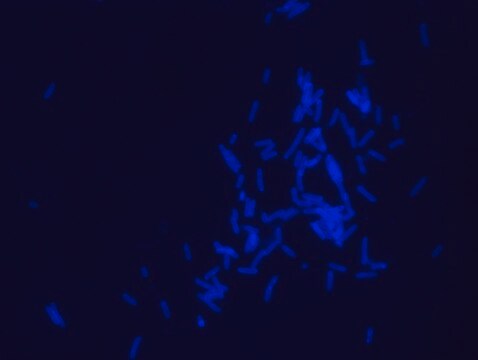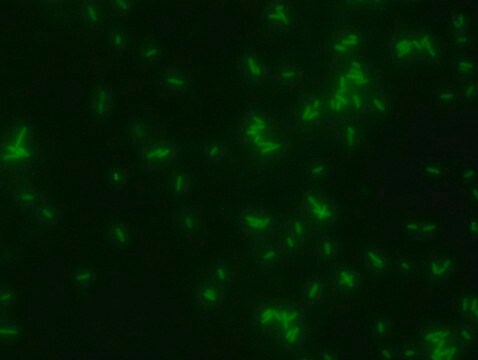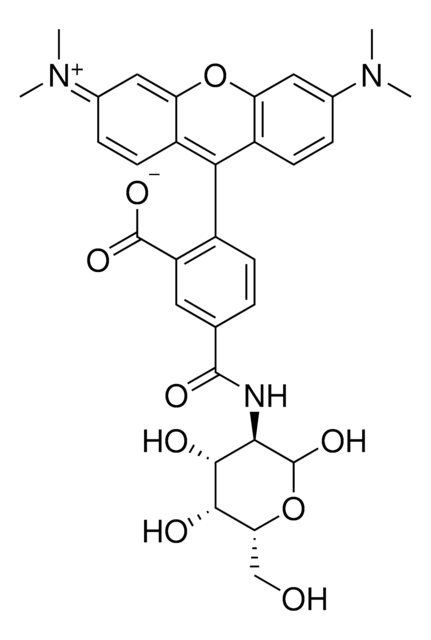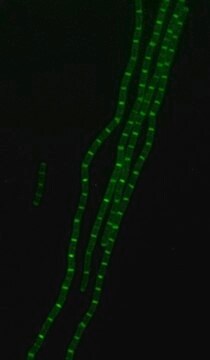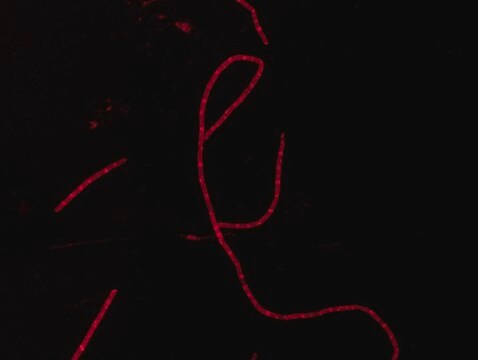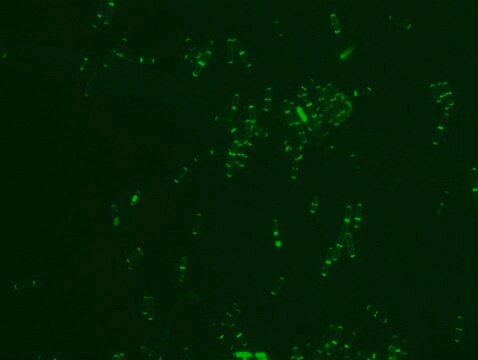Alle Fotos(3)
Wichtige Dokumente
SBR00069
Rhodamine labeled D-Lysine
Suitable for fluorescent microbial imaging
Synonym(e):
D-Lysine red, FDAA, TDL
Anmeldenzur Ansicht organisationsspezifischer und vertraglich vereinbarter Preise
Alle Fotos(3)
About This Item
Empirische Formel (Hill-System):
C31H34N4O6
CAS-Nummer:
Molekulargewicht:
558.62
UNSPSC-Code:
12352209
NACRES:
NA.21
Empfohlene Produkte
Allgemeine Beschreibung
Bacterial Peptidoglycan is a polymer consisting of sugars and amino acids, a mesh-like rigid layer that forms the cell wall. D-Amino Acids (D-AAs) are metabolically incorporated onto the bacterial cell wall by D,D-transpeptidase and/or L,D-transpeptidase. It was recently discovered that those transpeptidases catalyze the metabolic incorporation of exogenous D-AAs with almost no restriction of the side-chain identity. Modification of a D-AA with molecular fluorophores provides fluorescent D-amino acids that can efficiently label in situ peptidoglycan in diverse bacterial species. Rhodamine-Labeled D-lysine (TDL) is a fluorescent derivative of D-lysine that is obtained by a synthetic conjugation of D-lysine to the fluorophore. Rhodamine Labeled D-lysine has high biocompatibility and suitability for labeling peptidoglycans in live bacteria. Additionally, it can be used in tandem with other stains such as FITC-Labeled D-Alanine (SBR00049) to distinguish between different bacteria. Other compatible products useful for live staining include: Rhodamine B Labeled Polymyxin B, FITC Labeled D-Lysine, FITC Labeled Vancomycin and Dansyl Labeled Polymyxin B (SBR00036, SBR00050, SBR00028, SBR00029 and SBR00047).
Anwendung
Fluorescent labeled D-AAs (FDAAs) can be used for many applications including:
- Bacterial cell wall morphology
- Bacterial cell wall formation or remodeling activity
- Bacterial viability/activity
- Identify bacterial activity on surfaces or in substances
- Differentiation between various bacterial strains according to their incorporation profile of different D amino acids and sugars
Hinweis zur Analyse
- Fluorescent microscopy application: Rhodamine Labeled D-lysine has excitation/emission wavelength range at 550/570 nm.
- The recommended working concentration in fluorescent microscopy imaging application is between 250 µM-500 µM in working medium.
- Aliquots of the DMSO solution can be stored at -20 °C, protected from light for at least one month.
Ähnliches Produkt
Produkt-Nr.
Beschreibung
Preisangaben
Lagerklassenschlüssel
11 - Combustible Solids
WGK
WGK 3
Flammpunkt (°F)
Not applicable
Flammpunkt (°C)
Not applicable
Hier finden Sie alle aktuellen Versionen:
Analysenzertifikate (COA)
Lot/Batch Number
Leider sind derzeit keine COAs für dieses Produkt online verfügbar.
Wenn Sie Hilfe benötigen, wenden Sie sich bitte an Kundensupport
Besitzen Sie dieses Produkt bereits?
In der Dokumentenbibliothek finden Sie die Dokumentation zu den Produkten, die Sie kürzlich erworben haben.
Yen-Pang Hsu et al.
Chemical science, 8(9), 6313-6321 (2017-10-11)
Fluorescent d-amino acids (FDAAs) enable efficient in situ labeling of peptidoglycan in diverse bacterial species. Conducted by enzymes involved in peptidoglycan biosynthesis, FDAA labeling allows specific probing of cell wall formation/remodeling activity, bacterial growth and cell morphology. Their broad application
Helene Botella et al.
mBio, 8(5) (2017-09-14)
Peptidoglycan (PG), a polymer cross-linked by d-amino acid-containing peptides, is an essential component of the bacterial cell wall. We found that a fluorescent d-alanine analog (FDAA) incorporates chiefly at one of the two poles in Mycobacterium smegmatis but that polar
Unser Team von Wissenschaftlern verfügt über Erfahrung in allen Forschungsbereichen einschließlich Life Science, Materialwissenschaften, chemischer Synthese, Chromatographie, Analytik und vielen mehr..
Setzen Sie sich mit dem technischen Dienst in Verbindung.